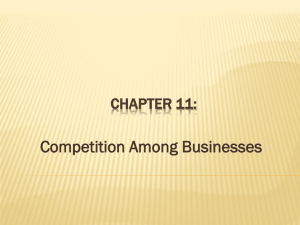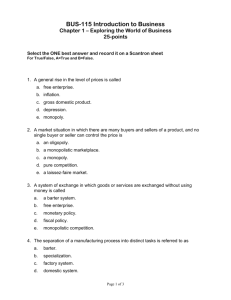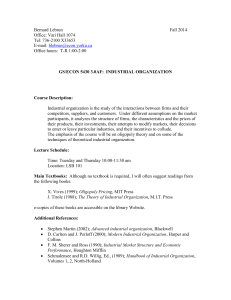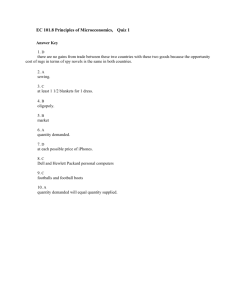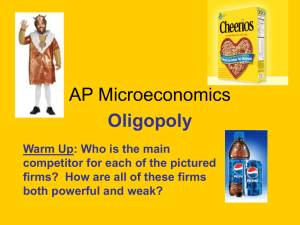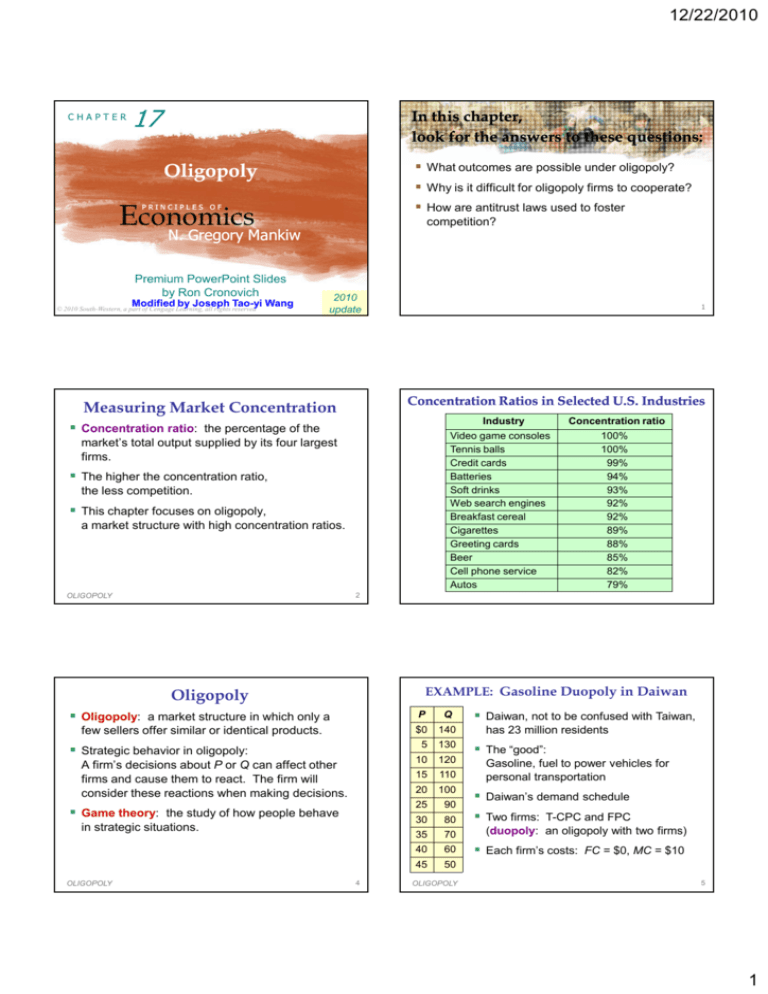
12/22/2010
CHAPTER
17
In this chapter,
look for the answers to these questions:
What outcomes are possible under oligopoly?
Why is it difficult for oligopoly firms to cooperate?
How are antitrust laws used to foster
Oligopoly
PRINCIPLES OF
Economics
competition?
N. Gregory Mankiw
Premium PowerPoint Slides
by Ron Cronovich
Modified by Joseph Tao-yi Wang
© 2010 South-Western, a part of Cengage Learning, all rights reserved
2010
update
1
Concentration Ratios in Selected U.S. Industries
Measuring Market Concentration
Industry
Concentration ratio: the percentage of the
Video game consoles
Tennis balls
Credit cards
Batteries
Soft drinks
Web search engines
Breakfast cereal
Cigarettes
Greeting cards
Beer
Cell phone service
Autos
market’s total output supplied by its four largest
firms.
The higher the concentration ratio,
the less competition.
This chapter focuses on oligopoly,
a market structure with high concentration ratios.
Concentration ratio
100%
100%
99%
94%
93%
92%
92%
89%
88%
85%
82%
79%
2
OLIGOPOLY
EXAMPLE: Gasoline Duopoly in Daiwan
Oligopoly
Daiwan, not to be confused with Taiwan,
Oligopoly: a market structure in which only a
P
Q
few sellers offer similar or identical products.
$0
140
5
130
10
120
15
110
20
100
25
90
Daiwan’s demand schedule
30
80
Two firms: T-CPC and FPC
35
70
(duopoly: an oligopoly with two firms)
40
60
Each firm’s costs: FC = $0, MC = $10
45
50
Strategic behavior in oligopoly:
A firm’s decisions about P or Q can affect other
firms and cause them to react. The firm will
consider these reactions when making decisions.
Game theory: the study of how people behave
in strategic situations.
OLIGOPOLY
4
OLIGOPOLY
has 23 million residents
The “good”:
Gasoline, fuel to power vehicles for
personal transportation
5
1
12/22/2010
EXAMPLE: Gasoline Duopoly in Daiwan
P
Q
Revenue
Cost
Profit
$0
140
5
130
650
1,300
–650
10
120
1,200
1,200
0
15
110
1,650
1,100
550
20
100
2,000
1,000
1,000
25
90
2,250
900
1,350
30
80
2,400
800
1,600
35
70
2,450
700
1,750
40
60
2,400
600
1,800
45
50
2,250
500
1,750
$0 $1,400 –1,400
EXAMPLE: Gasoline Duopoly in Daiwan
One possible duopoly outcome: collusion
Collusion: an agreement among firms in a
Competitive
outcome:
P = MC = $10
Q = 120
Profit = $0
market about quantities to produce or prices to
charge
T-CPC and FPC could agree to each produce half
of the monopoly output:
For each firm: Q = 30, P = $40, profits = $900
Monopoly
outcome:
P = $40
Q = 60
Profit = $1,800
Cartel: a group of firms acting in unison,
e.g., T-CPC and FPC in the outcome with
collusion
6
OLIGOPOLY
ACTIVE LEARNING
1
ACTIVE LEARNING
Collusion vs. selfself-interest
P
Q
$0
140
5
130
10
120
15
110
20
100
25
90
30
80
35
70
40
60
45
50
1
Answers
Duopoly outcome with collusion:
Each firm agrees to produce Q = 30,
earns profit = $900.
P
Q
$0
140
5
130
If T-CPC reneges on the agreement and
produces Q = 40, what happens to the
market price? T-CPC’s profits?
10
120
15
110
20
100
Is it in T-CPC’s interest to renege on the
agreement?
25
90
30
80
If both firms renege and produce Q = 40,
determine each firm’s profits.
35
70
40
60
45
50
8
Collusion vs. Self-Interest
If both firms stick to agreement,
each firm’s profit = $900
If T-CPC reneges on agreement and
produces Q = 40:
Market quantity = 70, P = $35
T-CPC’s profit = 40 x ($35 – 10) = $1000
T-CPC’s profits are higher if it reneges.
FPC will conclude the same, so
both firms renege, each produces Q = 40:
Market quantity = 80, P = $30
Each firm’s profit = 40 x ($30 – 10) = $800
9
ACTIVE LEARNING
2
The oligopoly equilibrium
Both firms would be better off if both stick to the
cartel agreement.
But each firm has incentive to renege on the
agreement.
Lesson:
It is difficult for oligopoly firms to form cartels and
honor their agreements.
OLIGOPOLY
7
OLIGOPOLY
10
P
Q
$0
140
5
130
10
120
15
110
20
100
25
90
30
80
35
70
40
60
45
50
If each firm produces Q = 40,
market quantity = 80
P = $30
each firm’s profit = $800
Is it in T-CPC’s interest to increase its
output further, to Q = 50?
Is it in FPC’s interest to increase its output
to Q = 50?
11
2
12/22/2010
ACTIVE LEARNING
The Equilibrium for an Oligopoly
2
Answers
P
Q
$0
140
5
130
10
120
15
110
20
100
25
90
30
80
35
70
40
60
45
50
Nash equilibrium: a situation in which
If each firm produces Q = 40,
then each firm’s profit = $800.
economic participants interacting with one another
each choose their best strategy given the strategies
that all the others have chosen
If T-CPC increases output to Q = 50:
Market quantity = 90, P = $25
T-CPC’s profit = 50 x ($25 – 10) = $750
Our duopoly example has a Nash equilibrium
in which each firm produces Q = 40.
T-CPC’s profits are higher at Q = 40
than at Q = 50.
Given that FPC produces Q = 40,
The same is true for FPC.
Given that T-CPC produces Q = 40,
T-CPC’s best move is to produce Q = 40.
FPC’s best move is to produce Q = 40.
12
13
OLIGOPOLY
The Output & Price Effects
A Comparison of Market Outcomes
Increasing output has two effects on a firm’s profits:
Output effect:
When firms in an oligopoly individually choose
production to maximize profit,
If P > MC, selling more output raises profits.
Price effect:
Raising production increases market quantity,
which reduces market price and reduces profit
on all units sold.
oligopoly Q is greater than monopoly Q
but smaller than competitive Q.
oligopoly P is greater than competitive P
but less than monopoly P.
If output effect > price effect,
the firm increases production.
If price effect > output effect,
the firm reduces production.
14
OLIGOPOLY
The Size of the Oligopoly
Game Theory
As the number of firms in the market increases,
the price effect becomes smaller
the oligopoly looks more and more like a
Game theory helps us understand oligopoly and
other situations where “players” interact and
behave strategically.
competitive market
Dominant strategy: a strategy that is best
P approaches MC
the market quantity approaches the socially
for a player in a game regardless of the
strategies chosen by the other players
efficient quantity
Prisoners’ dilemma: a “game” between
two captured criminals that illustrates
why cooperation is difficult even when it is
mutually beneficial
Another benefit of international trade:
Trade increases the number of firms competing,
increases Q, brings P closer to marginal cost
OLIGOPOLY
15
OLIGOPOLY
16
OLIGOPOLY
17
3
12/22/2010
Prisoners’ Dilemma Example
Prisoners’ Dilemma Example
Confessing is the dominant strategy for both players.
Nash equilibrium:
Bonnie’s decision
both confess
The police have caught Bonnie and Clyde,
two suspected bank robbers, but only have
enough evidence to imprison each for 1 year.
Confess
The police question each in separate rooms,
offer each the following deal:
Confess
If you confess and implicate your partner,
you go free.
Clyde’s
decision
If you do not confess but your partner implicates
you, you get 20 years in prison.
18
OLIGOPOLY
Prisoners’ Dilemma Example
But even if Bonnie and Clyde had agreed before
being caught to remain silent, the logic of selfinterest takes over and leads them to confess.
FPC’s profit
= $1000
OLIGOPOLY
3
The “fare wars” game
The players: China Airlines and EVA Air
T-CPC
Q = 40
21
OLIGOPOLY
ACTIVE LEARNING
Each firm’s dominant strategy: renege on agreement,
produce Q = 40.
T-CPC’s profit
= $750
19
OLIGOPOLY
Here is the “payoff matrix” for this example…
T-CPC & FPC in the Prisoners’ Dilemma
FPC
Clyde
gets 1 year
Each firm agrees to serve Q = 30 customers.
20
FPC’s profit
= $900
Bonnie gets
1 year
Our earlier example:
T-CPC and FPC are duopolists in Daiwan.
The cartel outcome maximizes profits:
silent.
Q = 30
Bonnie goes
free
of reaching the monopoly outcome,
they become players in a prisoners’ dilemma.
Both would have been better off if both remained
T-CPC’s
profit = $900
Clyde
goes free
When oligopolies form a cartel in hopes
each gets 8 years in prison.
Q = 30
Bonnie gets
20 years
Oligopolies as a Prisoners’ Dilemma
Outcome: Bonnie and Clyde both confess,
OLIGOPOLY
Clyde
gets 8 years
Remain
silent Clyde
gets 20 years
If you both confess, each gets 8 years in prison.
Remain silent
Bonnie gets
8 years
Q = 40
T-CPC’s profit
= $1000
FPC’s profit
= $750
T-CPC’s profit
= $800
FPC’s profit
= $800
The choice: cut fares by 50% or leave fares alone
If both airlines cut fares,
each airline’s profit = $400 million
If neither airline cuts fares,
each airline’s profit = $600 million
If only one airline cuts its fares,
its profit = $800 million
the other airline’s profits = $200 million
Draw the payoff matrix, find the Nash equilibrium.
22
23
4
12/22/2010
ACTIVE LEARNING
Other Examples of the Prisoners’ Dilemma
3
Answers
Nash equilibrium:
both firms cut fares
Ad Wars
Two firms spend millions on TV ads to steal
business from each other. Each firm’s ad
cancels out the effects of the other,
and both firms’ profits fall by the cost of the ads.
China Airlines
Cut fares
Don’t cut fares
$200 million
$400 million
Organization of Petroleum Exporting Countries
Member countries try to act like a cartel, agree to
limit oil production to boost prices & profits.
But agreements sometimes break down
when individual countries renege.
Cut fares
EVA Air
$400 million
$800 million
$600 million
$800 million
Don’t cut
fares
$200 million
$600 million
24
Other Examples of the Prisoners’ Dilemma
prevents them from achieving monopoly profits
Good for society:
Common resources
All would be better off if everyone conserved
common resources, but each person’s dominant
strategy is overusing the resources.
Q is closer to the socially efficient output
P is closer to MC
In other prisoners’ dilemmas, the inability to
cooperate may reduce social welfare.
e.g., arms race, overuse of common resources,
public goods contribution
Public goods contribution
Everyone would be better off if we all contributed to
the pool, but it’s a dominant strategy to free ride.
26
Another Example: Negative Campaign Ads
27
OLIGOPOLY
Another Example: Negative Campaign Ads
Each candidate’s
dominant strategy:
run attack ads.
Election with two candidates, “T” and “M.”
If T runs a negative ad attacking M,
T’s decision
Do not run attack
ads (cooperate)
1,000,000 fewer people will vote for M:
300,000 of them vote for T, the rest abstain.
Do not run
attack ads
(cooperate)
If M runs a negative ad attacking T,
T loses 1,000,000 votes, M gains 300,000,
700,000 abstain.
M’s decision
T and M agree to refrain from running attack ads.
Run
attack ads
(defect)
Will each one stick to the agreement?
OLIGOPOLY
Prisoners’ Dilemma and Society’s Welfare
The noncooperative oligopoly equilibrium
Bad for oligopoly firms:
Arms race between military superpowers
Each country would be better off if both disarm,
but each has a dominant strategy of arming.
OLIGOPOLY
25
OLIGOPOLY
28
OLIGOPOLY
Run attack ads
(defect)
no votes lost
or gained
no votes
lost or gained
T loses
1,000,000
votes
M gains
300,000 votes
T gains
300,000
votes
M loses
1,000,000 votes
M loses
700,000 votes
T loses
700,000
votes
29
5
12/22/2010
Another Example: Negative Campaign Ads
When the game is repeated many times,
Nash eq’m: both candidates run attack ads.
Effects on election outcome: NONE.
cooperation may be possible.
These strategies may lead to cooperation:
If your rival reneges in one round,
Each side’s ads cancel out the effects of the
other side’s ads.
you renege in all subsequent rounds.
“Tit-for-tat”
Whatever your rival does in one round
(whether renege or cooperate),
you do in the following round.
Effects on society: NEGATIVE.
Lower voter turnout, higher apathy about politics,
less voter scrutiny of elected officials’ actions.
OLIGOPOLY
Why People Sometimes Cooperate
30
Public Policy Toward Oligopolies
OLIGOPOLY
31
Restraint of Trade and Antitrust Laws
Recall one of the Ten Principles from Chap.1:
Sherman Antitrust Act (1890):
Governments can sometimes
improve market outcomes.
Forbids collusion between competitors
Clayton Antitrust Act (1914):
In oligopolies, production is too low and prices
Strengthened rights of individuals damaged by
anticompetitive arrangements between firms
are too high, relative to the social optimum.
Role for policymakers:
Promote competition, prevent cooperation
to move the oligopoly outcome closer to
the efficient outcome.
OLIGOPOLY
32
OLIGOPOLY
33
1. Resale Price Maintenance (“Fair Trade”)
Occurs when a manufacturer imposes lower limits
Controversies Over Antitrust Policy
Most people agree that price-fixing agreements
on the prices retailers can charge.
among competitors should be illegal.
Is often opposed because it appears to reduce
Some economists are concerned that
competition at the retail level.
policymakers go too far when using antitrust laws
to stifle business practices that are not
necessarily harmful, and may have legitimate
objectives.
Yet, any market power the manufacturer has
is at the wholesale level; manufacturers do not
gain from restricting competition at the retail level.
We consider three such practices…
The practice has a legitimate objective:
preventing discount retailers from free-riding
on the services provided by full-service retailers.
OLIGOPOLY
34
OLIGOPOLY
35
6
12/22/2010
2. Predatory Pricing
3. Tying
Occurs when a firm cuts prices to prevent entry
Occurs when a manufacturer bundles two products
or drive a competitor out of the market,
so that it can charge monopoly prices later.
together and sells them for one price (e.g., Microsoft
including a browser with its operating system)
Illegal under antitrust laws, but hard for the courts
Critics argue that tying gives firms more market
to determine when a price cut is predatory and
when it is competitive & beneficial to consumers.
power by connecting weak products to strong ones.
Others counter that tying cannot change market
Many economists doubt that predatory pricing is a
power: Buyers are not willing to pay more for two
goods together than for the goods separately.
rational strategy:
It involves selling at a loss, which is extremely
costly for the firm.
It can backfire.
Firms may use tying for price discrimination,
which is not illegal, and which sometimes
increases economic efficiency.
36
OLIGOPOLY
37
OLIGOPOLY
CHAPTER SUMMARY
CONCLUSION
Oligopolies can end up looking like monopolies
or like competitive markets, depending on the
number of firms and how cooperative they are.
Oligopolists can maximize profits if they form a
cartel and act like a monopolist.
The prisoners’ dilemma shows how difficult it is
Yet, self-interest leads each oligopolist to a higher
for firms to maintain cooperation, even when
doing so is in their best interest.
quantity and lower price than under the monopoly
outcome.
Policymakers use the antitrust laws to regulate
The larger the number of firms, the closer will be
oligopolists’ behavior. The proper scope of these
laws is the subject of ongoing controversy.
OLIGOPOLY
the quantity and price to the levels that would
prevail under competition.
39
38
CHAPTER SUMMARY
Oligopoly
When there are only a few firms
Firms care about each other’s actions
Game Theory; Nash Equilibrium; P.D.
Collusion (Monopoly) vs. Self-Interest
Policy: Increase competition; antitrust
Homework: Mankiw, Ch. 17, pp.386-388,
The prisoners’ dilemma shows that self-interest
can prevent people from cooperating, even when
cooperation is in their mutual interest. The logic of
the prisoners’ dilemma applies in many situations.
Policymakers use the antitrust laws to prevent
oligopolies from engaging in anticompetitive
behavior such as price-fixing. But the application
of these laws is sometimes controversial.
Problem 3, 5, 7, 8, 9, 10
40
7
12/22/2010
Oligopoly
True or False. The firms that sell personal
computers have never banded together to
form a cartel. We may infer from this that at
least one firm would fail to benefit from a
successful cartel.
True or False. When all firms in an industry
charge the same price, this is evidence of
collusion.
8





